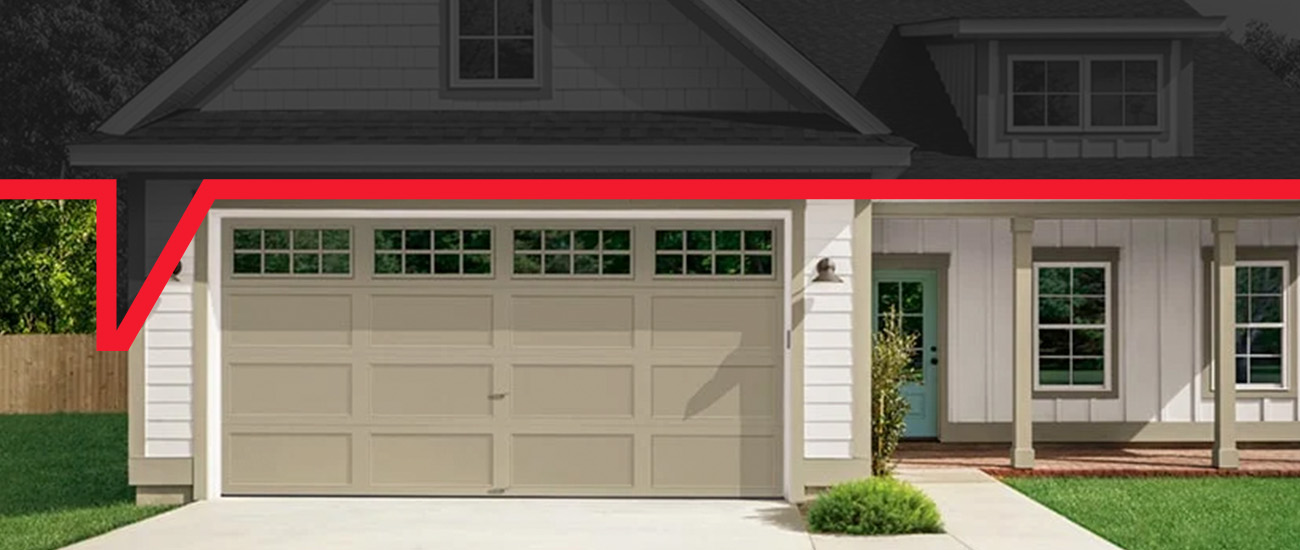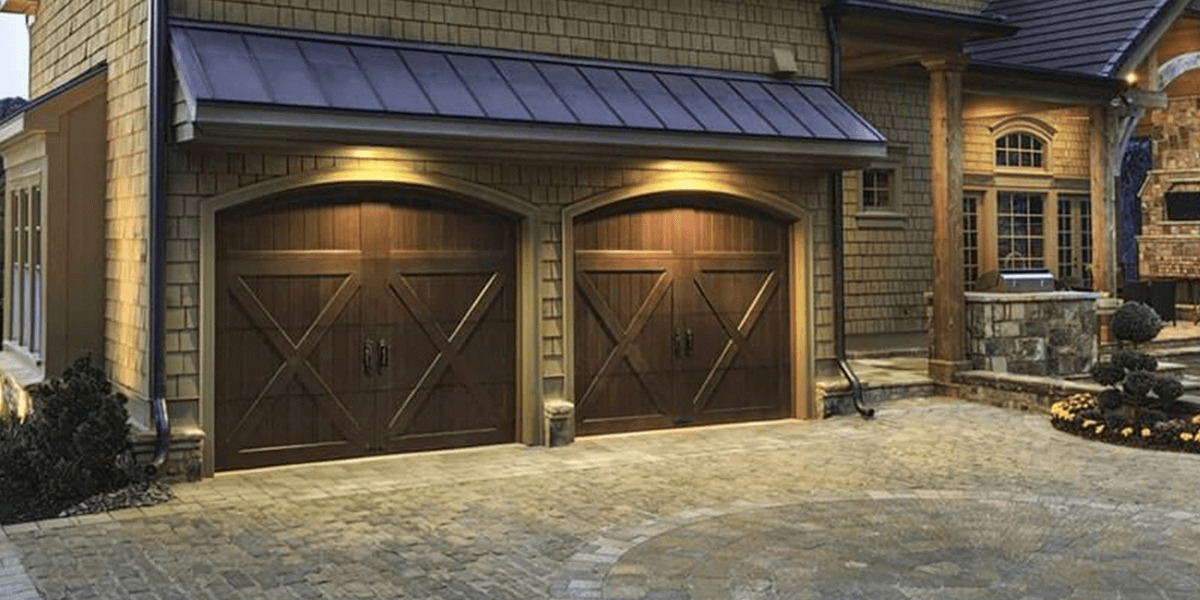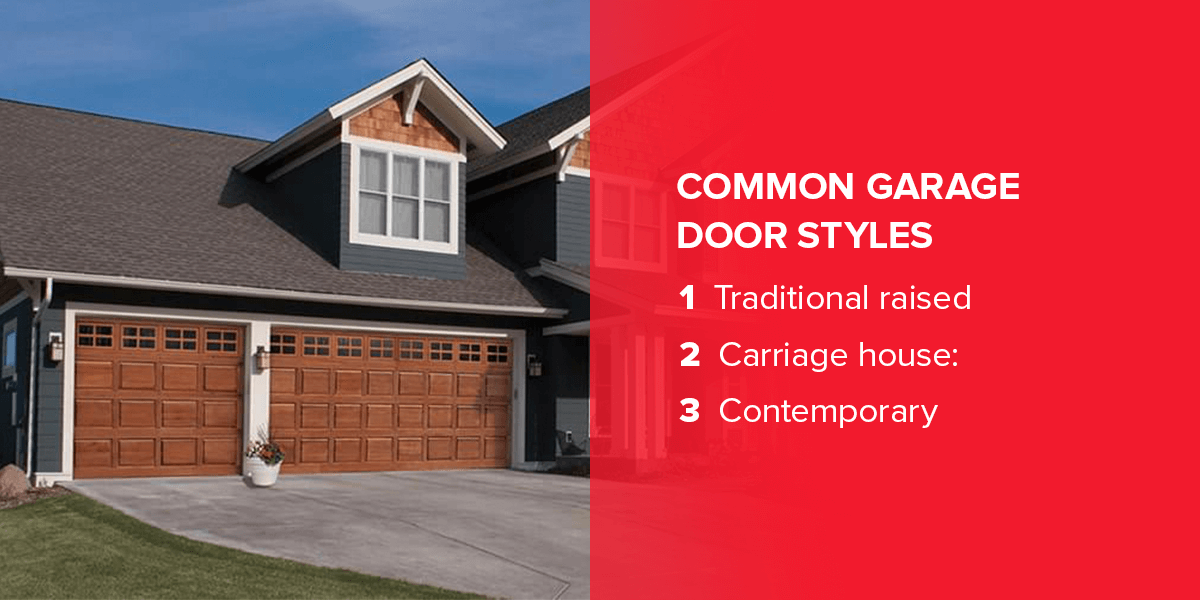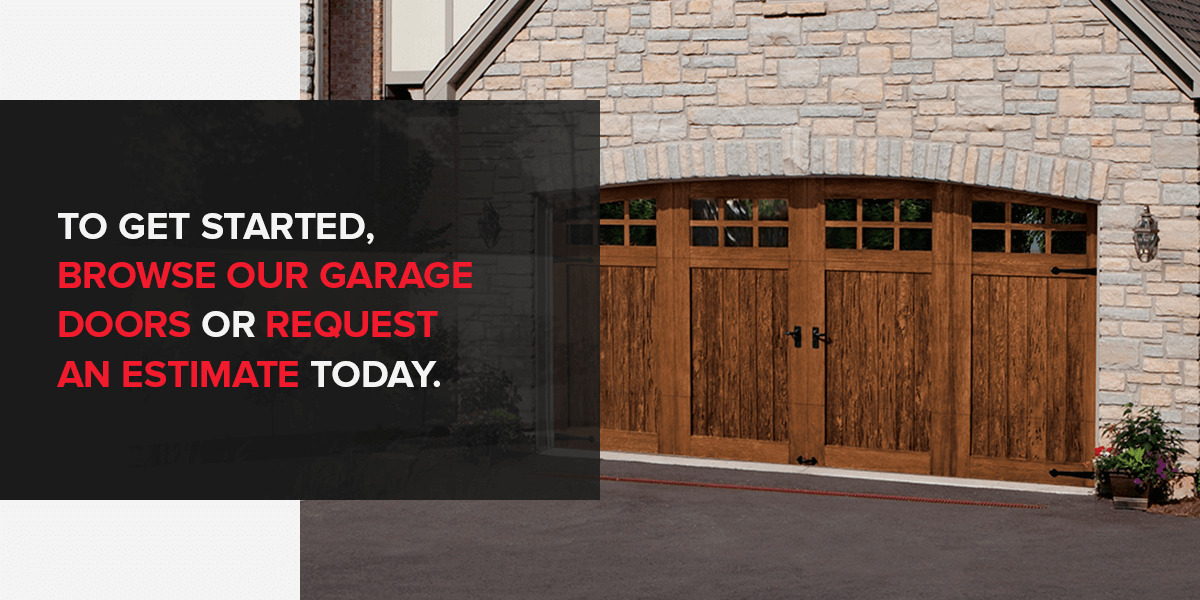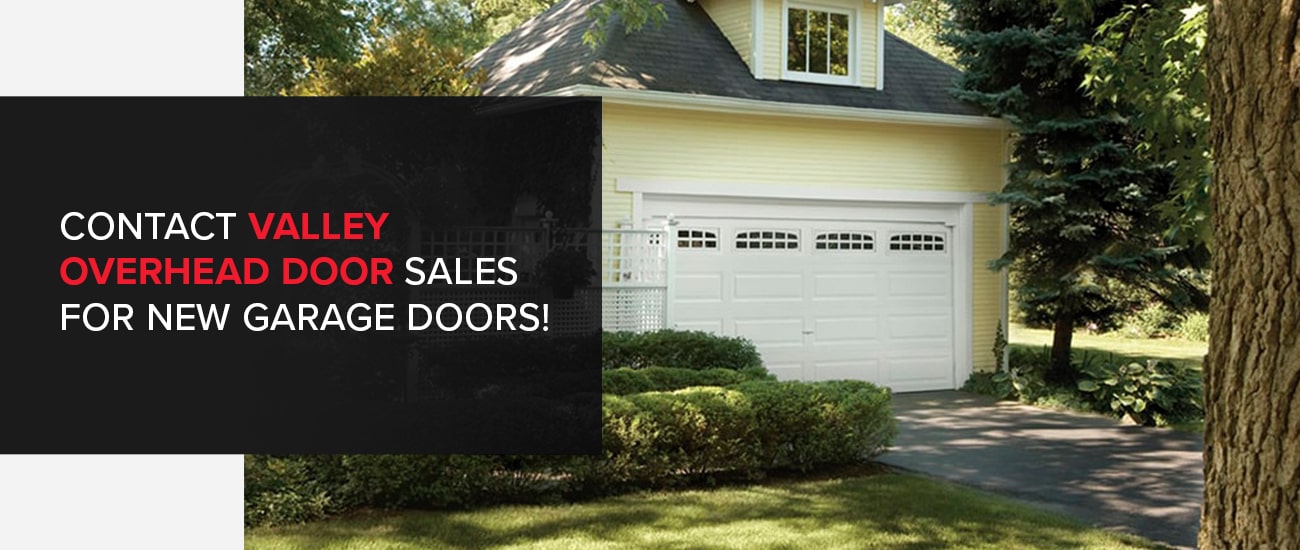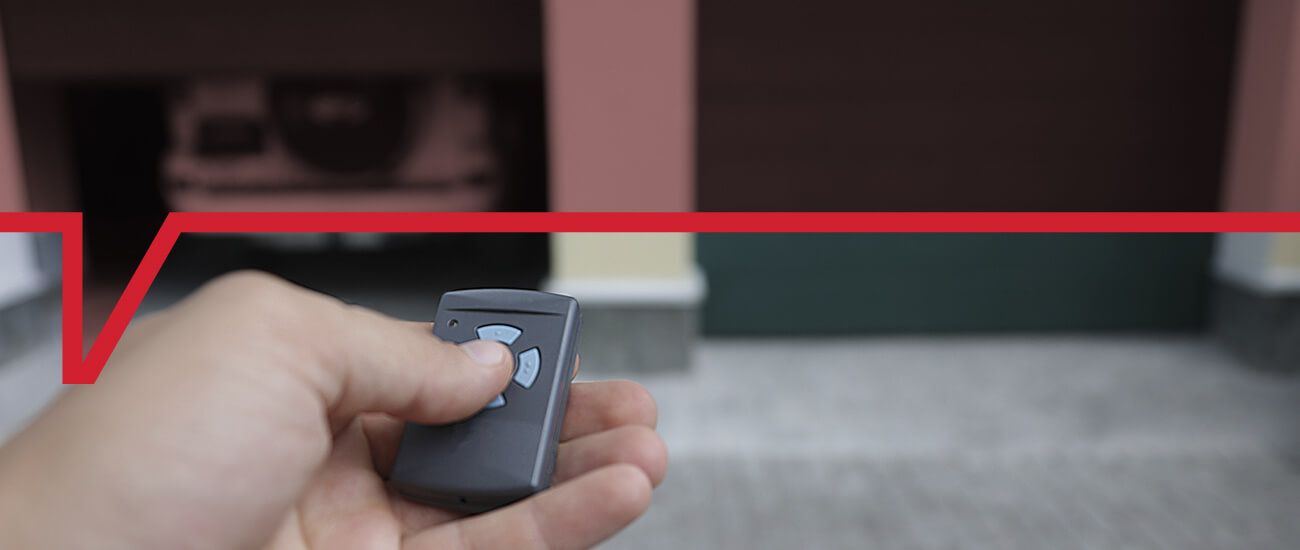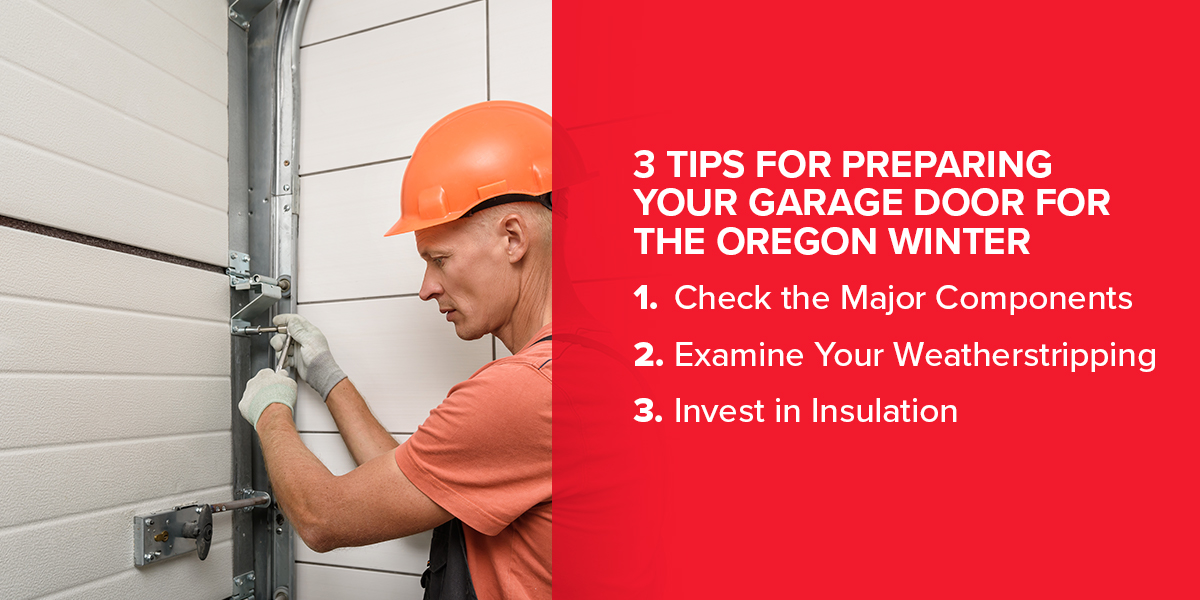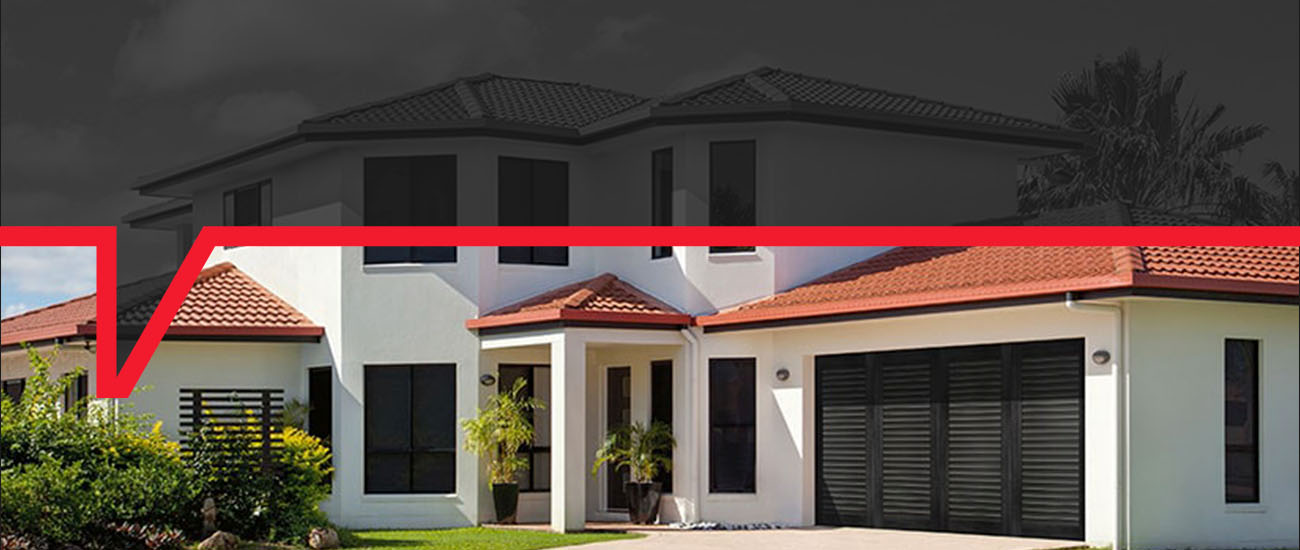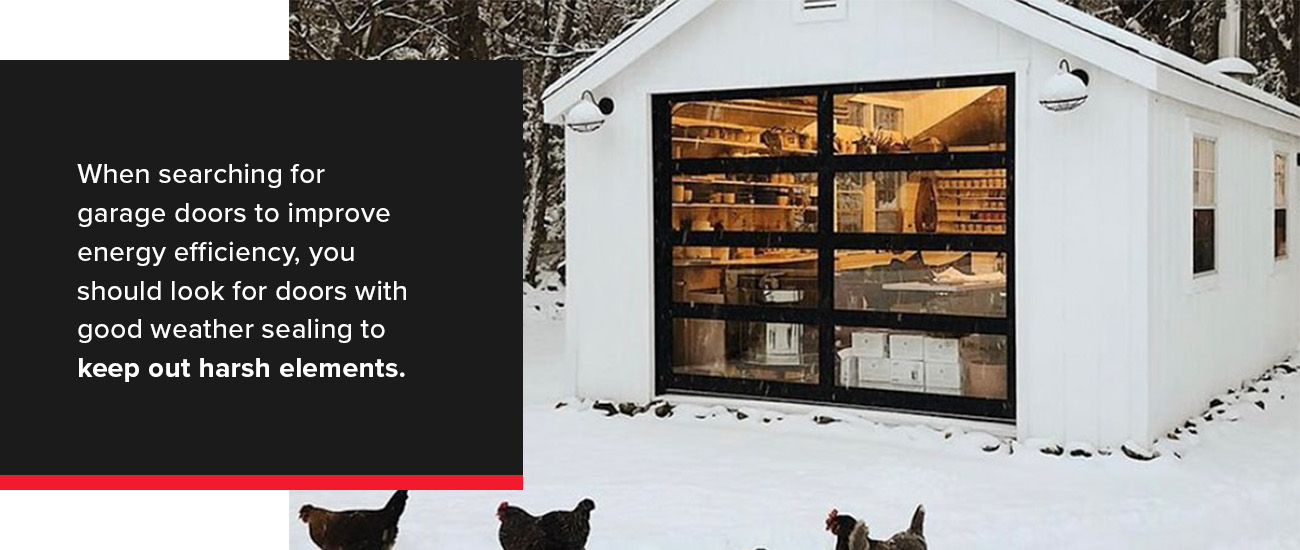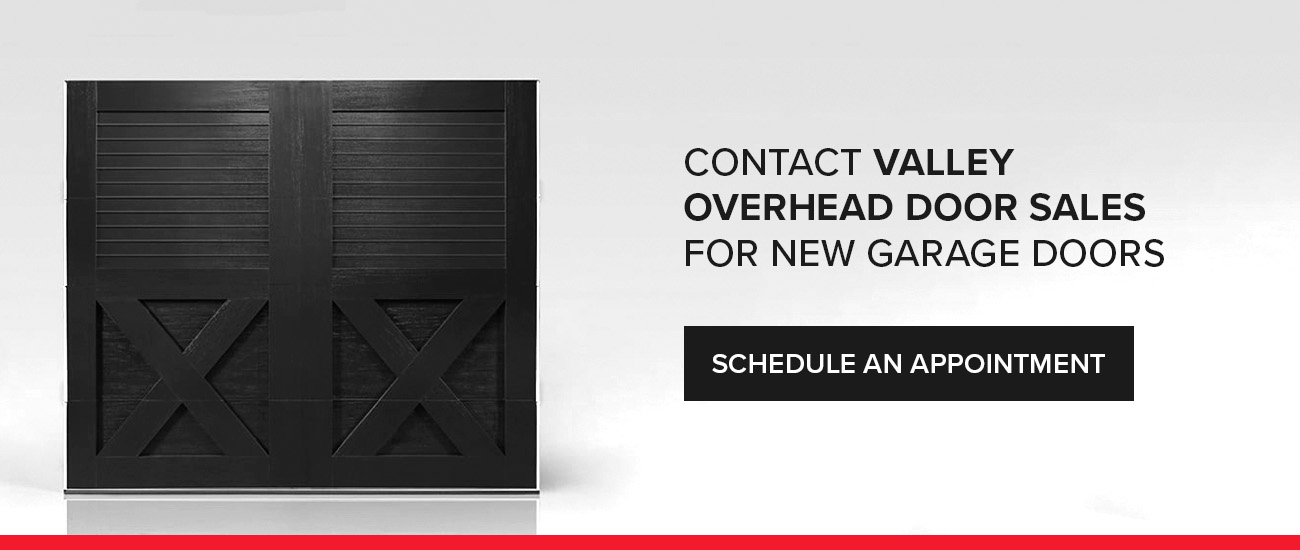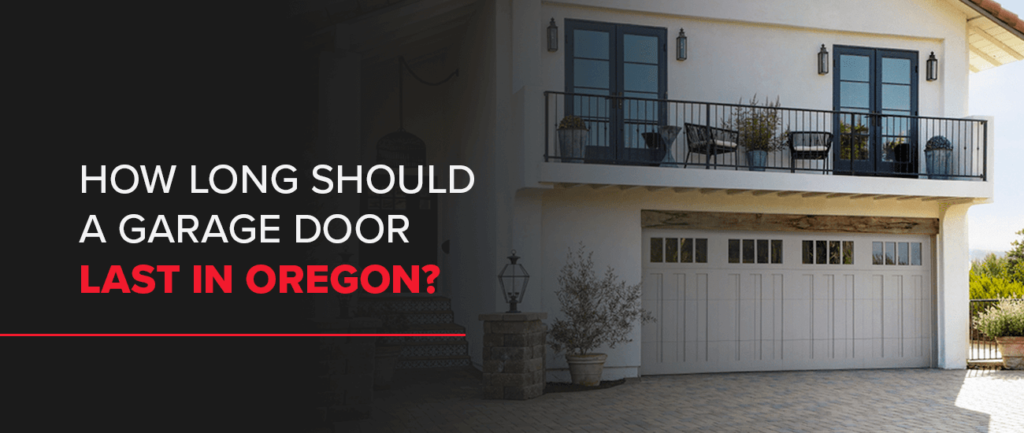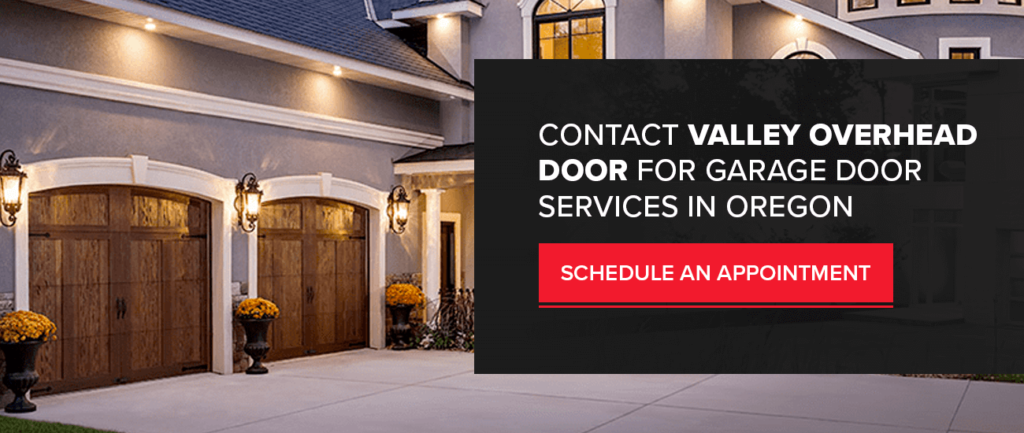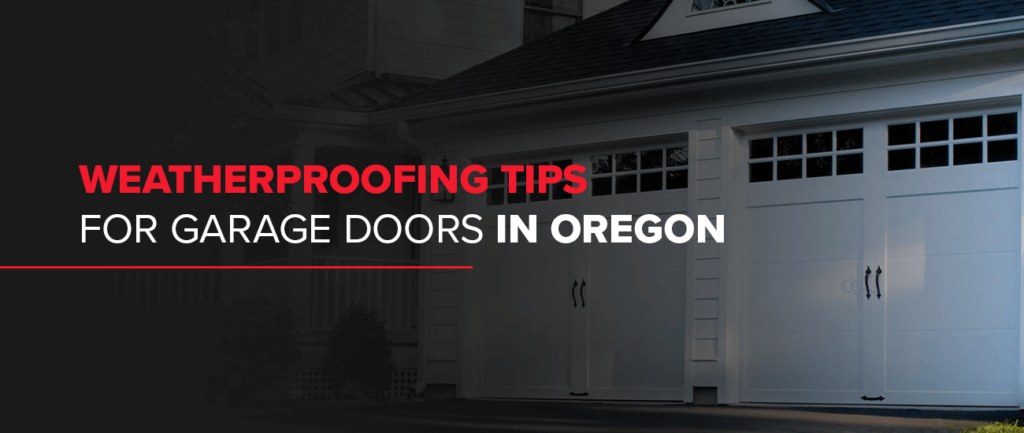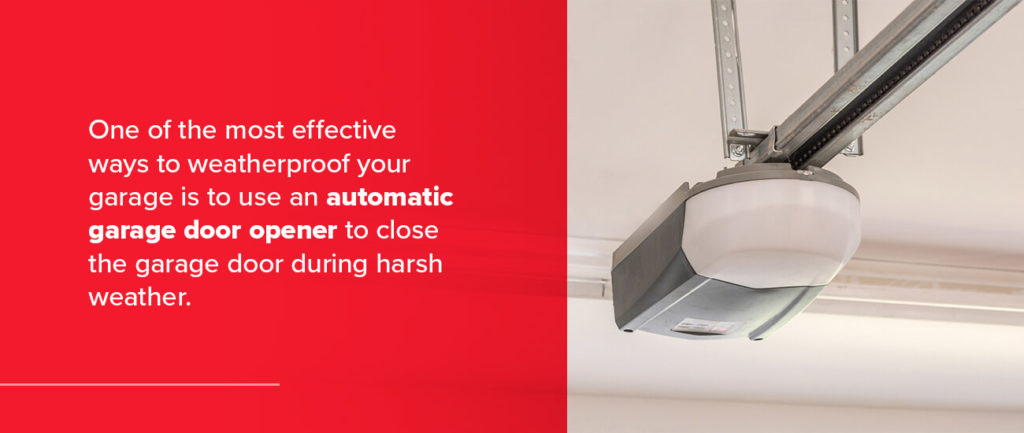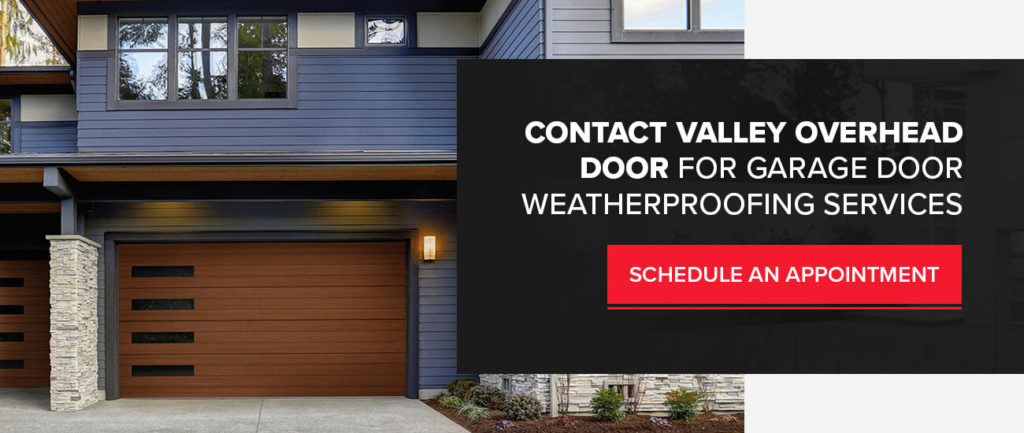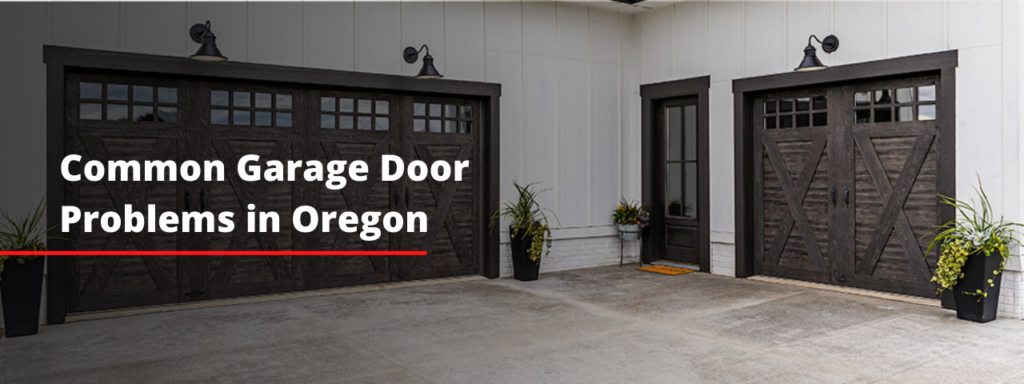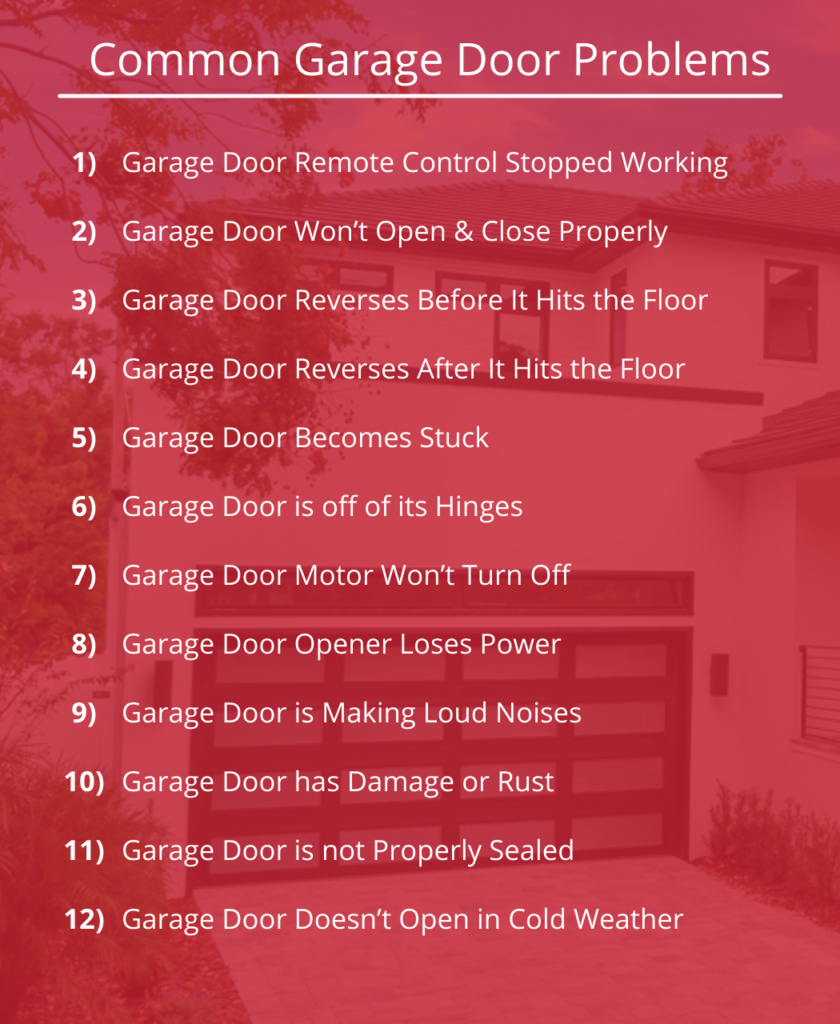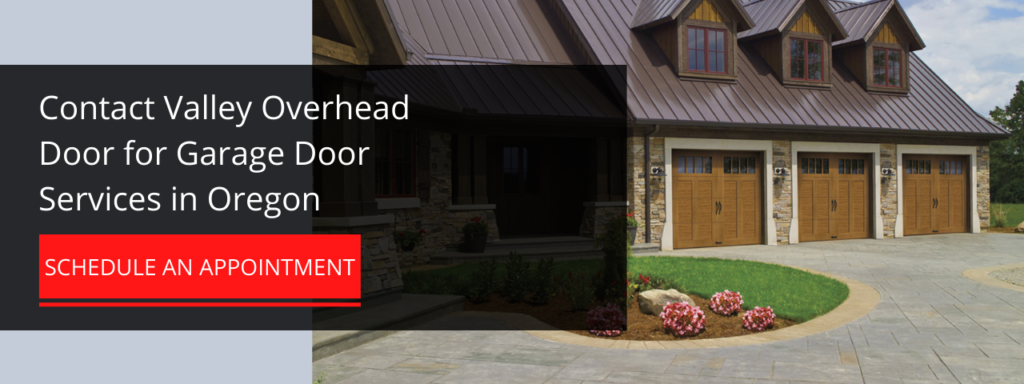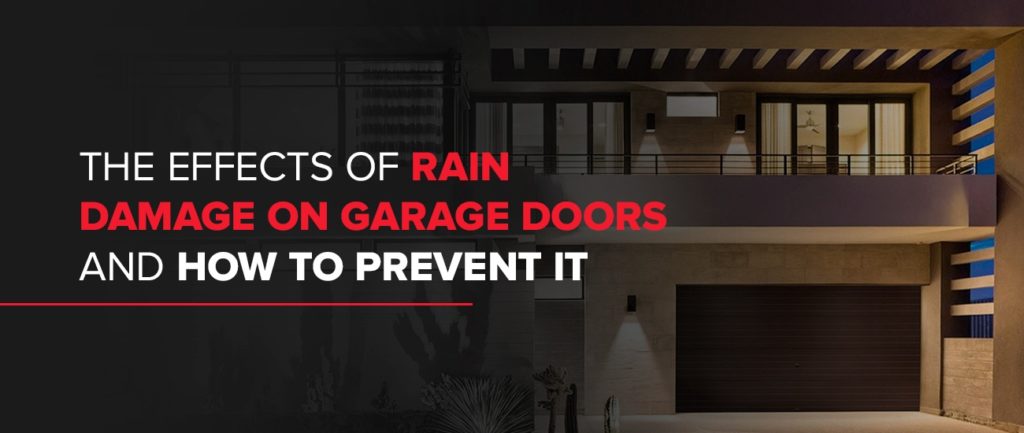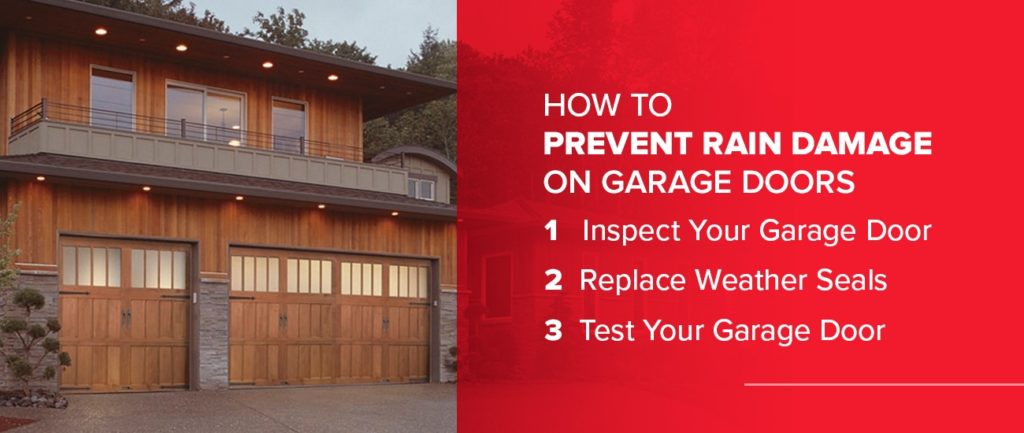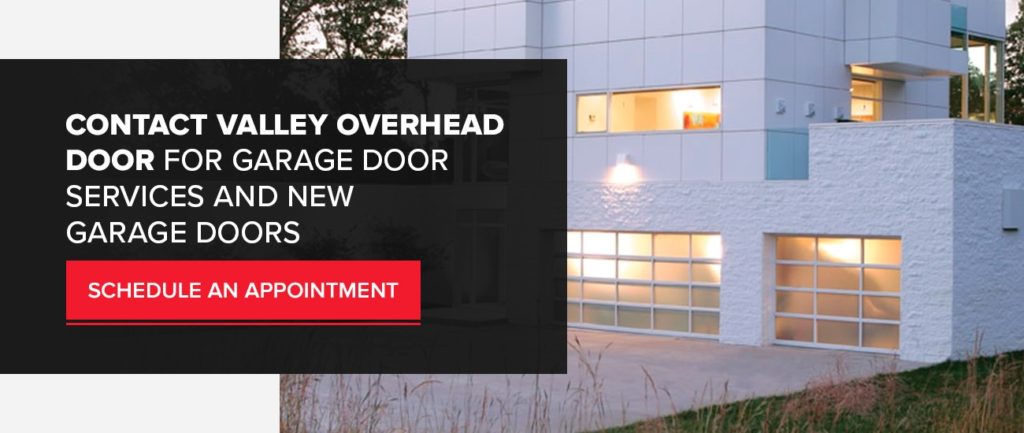How to Choose the Right Material for Your Garage Door in Oregon
When it comes to choosing the right material for your garage door in Oregon, doing your research is essential. Oregon’s diverse climate calls for materials that can withstand both rain and snow. It’s a good idea to look for options that are resistant to moisture and can handle the temperature fluctuations of the Pacific Northwest.
Learn more about the best garage door material options to enhance the curb appeal and security of your home.
Which Material Should I Choose for My Garage Door?
Overhead doors can be made from a variety of materials, each with its own level of durability and weather resistance. Explore the pros and cons of the following options from Clopay®:
- Steel: This is a popular metal for garage doors due to its exceptional durability and strength. Steel provides excellent security and is highly resistant to dents and impacts. Doors made from steel are available in a variety of styles, including Classic™ Steel and Gallery® Steel. You can customize your new door to suit your taste, style and property’s aesthetic.
- Aluminum: This metal is known for its strength, lightweight construction and resistance to corrosion. Aluminum doors like Avante® are an excellent choice for modern and contemporary architectural styles. They’re also low-maintenance, UV-resistant and can stand up against harsh weather.
- Composite: Composite doors like Coachman® combine various materials to offer durability, aesthetics and less maintenance. They can mimic the appearance of wood while providing enhanced resistance to the elements.
- Wood: Wood garage doors, including Classic™ Wood and Reserve® Wood Modern, are known for their natural appeal and timeless beauty. These doors can be customized with various finishes and stains to create a unique look.
Why Work With Valley Overhead Door?
At Valley Overhead Door, we are committed to carrying top-quality products that can withstand Oregon’s weather for years to come. Benefits of working with us include:
- Wide range of material choices: Whether you prefer the classic elegance of wood, the durability of steel or the lightweight versatility of aluminum, we have you covered.
- Customization options: Personalize your garage door to suit your taste with a variety of customization choices.
- Expert installation and service: Our team offers a full range of garage door services, including repairs and installation. Trust us to install your new overhead door.
- Reliable garage door openers: In addition to helping you find the perfect door for your garage, we carry many types of garage door openers from LiftMaster®.
Contact Us for an Estimate
We take pride in offering garage door products from leading brands matched with our reliable services. Get in touch with us to request a quote today.
What You Should Consider Before Buying a New Garage Door in Oregon
A new garage door can keep you safe, improve energy savings and transform your home’s curb appeal. But finding the right one can feel challenging. To make a confident purchase, you’ll first want to consider a few factors. From durability and functionality to aesthetics and materials, here’s what to consider when buying a new garage door in Oregon.
Functionality
Buying a garage door in Oregon means considering the weather for year-round functionality. From standard sectional doors that ride on parallel tracks to swing-style options, there are various styles you can choose from to fit your desired use. You might also consider insulated or noninsulated options and galvanized steel or low-maintenance materials.
For example, if you’re using your garage as a mixed-use space or workshop, an insulated door can be an excellent option for the warmth and energy savings it’ll provide. However, if you’re using it for storage, a noninsulated door can reduce your upfront costs. You might also hope to install a glass door or windows that accommodate plenty of natural lighting so that you can work in your garage during the day without opening the door or turning on lights.
Size
If you already have a garage door, it’s fairly simple to take measurements. However, you’ll have more to consider if you’re building a new one or extending an existing door. A typical single-size garage door is about 7 feet tall and 8 feet wide. A double-car garage door can range in size, though the most common is 7 tall and 16 feet wide.
To measure your current garage, start with the width and height of the opening. Then, move to the side of the door and measure the width from the wall to the opening. Next, measure your garage’s depth. Lastly, take a measurement of your garage’s headroom, or the space between your ceiling and the top of the garage door. If you cannot find a door that fits your garage’s measurements, you can get a custom-made garage door.
Materials
Considering functionality and aesthetics, think about the materials you’d like your garage door to be made of. Most of your door’s value is in its materials, as its longevity depends on these crucial parts. It’s also essential to remember that buying a high-quality door from a trusted manufacturer can ensure it lasts years.
Your garage door’s thickness will correspond with insulation levels and materials. Higher insulation levels hold onto heat and dampen sounds. For instance, steel doors can come in one- to five-layer constructions, depending on the heat and sound reduction level you’re looking for. Aluminum and glass garage doors also have layer options depending on the insulation and type of construction you’re looking for.
The following are common garage door materials:
- Steel: These doors are the most popular construction materials. They are affordable, durable, safe and require minimal maintenance. If you choose steel, you might opt for 24 gauge to prevent denting, especially for doors that aren’t insulated. Anything less will result in a thinner door.
- Aluminum: Aluminum is a popular choice in humid environments since they’re more corrosion- and rust-resistant. The lightweight material prevents excess strain on the door’s other hardware mechanisms. Thus, aluminum garage doors are often easy to install and require little maintenance.
- Glass: These garage doors are rising in popularity due to their attractive look and ability to accommodate natural light. They’re also low maintenance and durable, with tempered glass options offering additional strength.
If you’re unsure what to look for in a garage door in Oregon, consider a style that will do well in our weather. For instance, while wooden doors provide an attractive and rustic look that’s easy to paint and customize, they might not fare as well as other materials due to the high amount of rain the state experiences year-round.
You’ll also want to consider your garage door’s springs and rollers. Most have torsion springs to ensure your door rises easily and lowers slowly. Investing in heavy-duty springs can increase your door’s life expectancy, providing a great return on investment and giving you years to enjoy it. Further, investing in the right rollers can contribute to sound dampening, allowing your door to move along the tracks effortlessly and quietly.
Style
While you’ll want a low-maintenance garage door built to last, curb appeal is also crucial. An attractive garage door that matches your home exterior is beneficial if you want to increase its overall value.
There are three main garage door styles to choose from, depending on the aesthetic you’re looking for. Each can come in various colors, finishes and materials. You might also consider customizing your garage door to fit your taste. Here’s a look at some common garage door styles:
- Traditional raised: The standard raised-panel garage doors are ideal for a simple, classic style that complements your home’s exterior. Symmetric rectangular panels make this type of door stand out, making it one of the most favored styles. You’re sure to find several traditional raised garage doors in various materials and colors. Whether you have a Cape Cod-style home or a Tudor, these doors will enhance your home’s exterior.
- Carriage house: The carriage house style doors replicate the style found in carriage houses of the past, though their timeless look is still popular today. Their decorative appearance offers a charming look, complementing both modern and historic home styles. While traditional carriage doors swing outwards and are made of wood, modern ones can open just like standard garage doors.
- Contemporary: A modern home should have a garage door to match. Modern garage doors are functional and sleek, complementing newer architectural styles. You can explore various contemporary designs, though steel and aluminum are popular choices for many homeowners.
Ultimately, the style you go for should match the style and needs of your home. That way, you can match your aesthetic and increase your home’s curb appeal and overall value.
Installation
While it can be tempting to install your own garage door, hiring a professional will save you more in the long run. It’s also crucial to avoid repairing or installing a door alone for safety purposes. Your time and safety are valuable, so hiring professionals is essential. Experts can save you time on this important project and ensure your safety. They’ll provide the expertise and experience to get the job done right and can even replace your old door opener simultaneously to save you time.
Purchase a Garage Door in Oregon
Choosing a garage door goes beyond style and aesthetics. You’ll want to consider your garage’s functionality, size, materials and installation. When you’re ready to make a purchase, connecting with a trusted and quality garage door company will ensure greater peace of mind about your installation.
If you’re looking for installation or are unsure what to consider when buying a new garage door in Oregon, trust the expert team at Valley Overhead Door. We offer new garage doors in various styles and provide installation and repair services for homeowners near Albany, Salem and Corvallis.
To get started, browse our garage doors or request an estimate today.
How to Clean Your Garage Door in Oregon
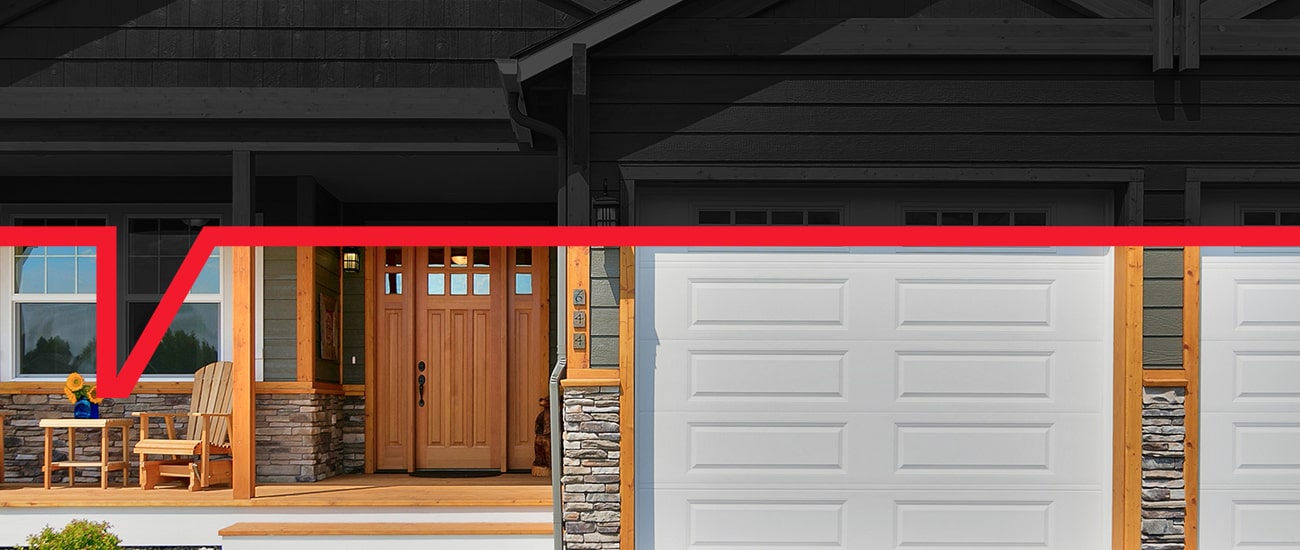
- Benefits of Cleaning Your Garage Door
- How Often Should You Clean Your Garage Door?
- Supplies You Need to Clean Your Garage Door
- How to Clean Your Garage Door
- How to Remove Stains From Garage Doors
- How to Wax Your Garage Door
- Where to Buy New Garage Doors in Oregon
With so many household chores to take care of, it’s easy to put cleaning your garage door at the bottom of the list. However, cleaning the garage door is essential to maintaining its appearance and function. A garage door is a significant investment for any homeowner — they last years and ensure the safety and security of your home. Taking good care of them will help keep your house looking nice and protect your garage door from wear and tear.
Whether you need to give your garage door a deep clean or you want to know what cleaning schedule to follow, we’ve got all the information you need. Here are some garage door cleaning tips to help you get started.
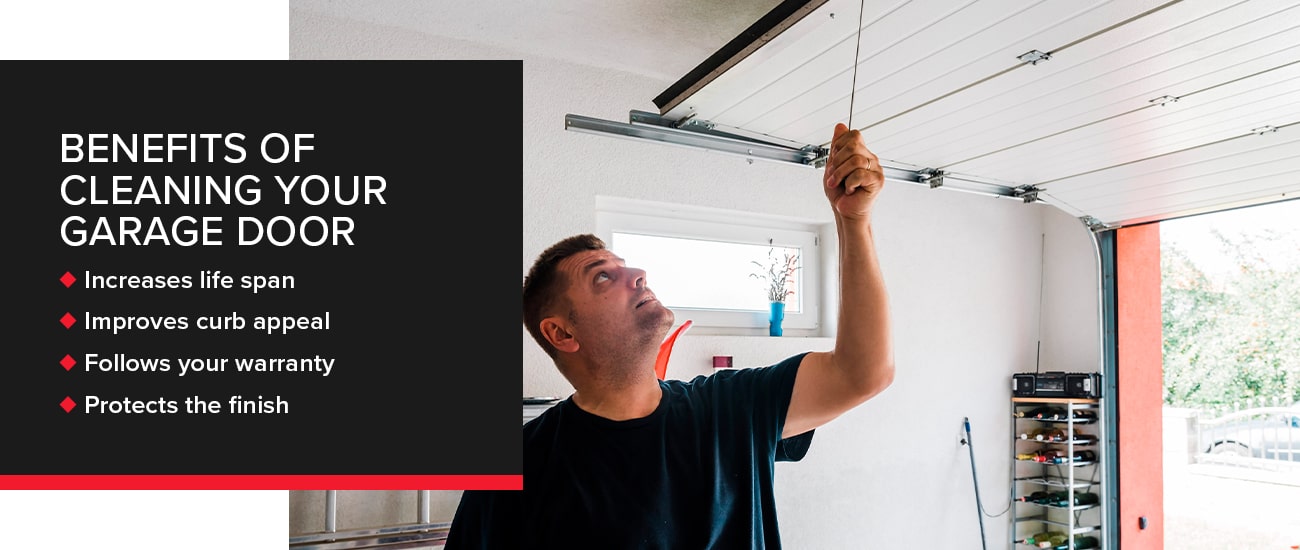
Benefits of Cleaning Your Garage Door
Cleaning garage doors is an essential part of garage door maintenance for Oregon homeowners. Cleaning, like other maintenance, helps ensure your garage door’s strength and appeal. Without it, you may have to invest in significant garage door service costs more frequently. Some of the benefits of garage door cleaning include the following:
- Increases life span: A quality garage door will last 15 to 30 years when well-maintained. However, ignoring cleanings can allow rust, dirt and grime to build up on your garage door. Too much rust eats away at the door, weakening it and making it necessary to get repairs more frequently. Excessive grime will collect in the hinges and between panels, impacting the use and look of your door. Keep it clean to extend its working life.
- Improves curb appeal: A sparking, fresh garage door elevates the look of your home. The cleaner and more well-kept your garage door, the nicer your home will look and the better you’ll feel about your space. Additionally, a clean exterior is vital for homeowners looking to sell since buyers want a home that looks cared-for and new.
- Follows your warranty: Many garage door warranties require regular cleaning. If you fail to keep up with your door, it could void the warranty — if you were to need repairs or a replacement, you wouldn’t be able to rely on the warranty for assistance.
- Protects the finish: A garage door’s finish makes the door look nicer and protects it from damage — especially for wood doors. Water, sun, grit and dirt will all wear the finish away over time. Wear and tear dulls your door’s look and leaves your door material unprotected — regular cleaning helps protect the finish from erosion.
How Often Should You Clean Your Garage Door?
You should clean your garage door twice a year — once in spring and once in fall. Cleaning in the spring helps remove grime and buildup from snow, salt, wind, pollen and rain. Cleaning in the fall helps clear debris from summer and falling leaves. Additionally, you should do it before winterizing your garage door, so you have a clean slate to work with.
\If you live in an area like Oregon that sees lots of rain, wind and weathering, you should clean your garage door at least once a season to keep it durable and looking fresh.
Supplies You Need to Clean Your Garage Door
Before you can start cleaning, you’ll need the right tools. Make sure you have:
- A soft-bristle brush, wet cloth or non-abrasive sponge
- Several clean cloths for wiping
- A mild cleaning solution or detergent
- A two-gallon bucket of warm water or a hose
- A step-ladder to reach the top of the garage
Once you have these materials, you’re ready to get started.
How to Clean Your Garage Door
When you’ve gathered your supplies, you should pick a mild day with some sun to clean your garage. You want to avoid working when it’s too hot or cold, as it could strain your body excessively and affect how clean you get your garage door. Here are the steps for washing your garage door:
- Take your clean cloth and wipe the garage door and stop molding. This removes any surface dirt and clears away tiny rocks and grit.
- Use water to get the garage door wet and ready for the cleaner.
- Wet your brush, sponge or cloth in a solution of cleaner and water.
- Begin scrubbing the garage door thoroughly, starting at the top and working your way down. Make sure to get all your trim and weatherstripping as well. Wash the door’s interior and exterior.
- Use clean water to wash away all the grime and soap.
- Take a clean cloth and wipe the door to remove any remaining moisture and suds.
These steps will work for all garage door materials. To avoid damaging the door, ensure you’re using a non-toxic, biodegradable cleaner that won’t impact your garage door finish.
How to Remove Stains From Garage Doors
Your garage door might have some stubborn stains you fail to clear with a regular wash. Try scrubbing extra hard with your cleaner and water — many stains will come off with extra elbow grease.
If you have an extra-stubborn stain, depending on your garage door material, you might be able to use a diluted mixture of bleach and water to spot clean. Ensure you thoroughly rinse any cleaning solution with water before using your bleach-water mixture — you never want to mix cleaners. Use this method with restraint — bleach can eat away at the door’s finish, causing more damage.
If your garage door is wood, you should avoid using bleach. Bleach can permanently damage the wood and discolor its stain. If you’re unsure about the safety of bleach, it’s always best to use only a mild detergent rather than harm your garage door.
How to Wax Your Garage Door
If you have a steel garage door, you’ll need to wax it to maintain its durability and finish. Use a liquid wax and apply it to your door according to the manufacturer’s instructions. Remember to wax the interior’s bottom section, as this area is exposed to the elements occasionally.
Contact Valley Overhead Door Sales for New Garage Doors!
Garage doors are an essential part of your home — trust the experts at Valley Overhead Door Sales to help you keep them in top condition. While maintenance is necessary for a lasting garage door, you will need repairs at some point. Our professional garage door repair services get your door back into shape quickly and efficiently, helping you enjoy your door for many more years.
Looking to upgrade your garage door? We sell high-quality Clopay® garage doors built to withstand years of use. With decades of experience, you can rely on our technicians to provide unmatched garage door services. If you’re interested in our services, contact us to request an estimate or request a service online today!
Garage Door Opener Buying Guide: How to Choose the Right Garage Door Opener
- Choosing a Garage Door Opener and Understanding the Various Features
- Garage Door Opener Types
- Where to Buy Garage Door Openers in Oregon
If your Oregon home has a garage, you probably rely on an opener to raise and lower the door. You can operate this device via a wall switch or a remote control unit in your vehicle, preventing the need to open or close the door manually.
Like most mechanical devices, a garage door opener won’t last forever. The average service life of an opener is 10-15 years, although heavy usage and other factors can shorten the time frame.
If you’re like many homeowners, you may only purchase a garage door opener once or twice in your lifetime. With so many options available on the market, selecting the right device for your needs and budget can be challenging. Valley Overhead Door has prepared the following garage door opener buying guide to simplify the process.
Choosing a Garage Door Opener and Understanding the Various Features
If it’s been a few years since you’ve purchased a garage door opener or you’re a first-time buyer, you might be surprised at the wide range of product features available today.
While numerous options are available, these features typically deliver the maximum value and convenience to most homeowners.
Keypad Functionality
While you may use the opener’s remote control unit to operate the door, there may be times when this device isn’t accessible or practical. Installing an exterior wireless keypad next to the garage door enables you and other members of your household to raise or lower the door without the remote by entering a secure code. You won’t have to worry if you lose the remote or don’t have it in your vehicle for any reason.
Battery Backup
If you currently have an older opener model, you may experience the hassle of disengaging it and opening or closing the door manually whenever a power outage occurs. If you upgrade to a newer opener with a built-in battery backup system, your door will continue to function without interruptions.
Rolling Code Technology
Did you know that an enterprising thief can use a device that mimics the code transmitted by your opener’s remote control unit to break into your garage? Fortunately, rolling code technology automatically changes the code every time you open or close the door, significantly reducing this risk.
Smartphone Compatibility
You may already use your smartphone to lock and unlock your home’s exterior doors, control the lighting and operate appliances. You can also purchase a Wi-FI-enabled garage door opener that allows you to open and close the door remotely from any location. If you suddenly realize you forgot to close the door when leaving for work, you can handle the task with a quick tap of a button on a mobile app.
Garage Door Opener Types
You can also choose from various types of garage door openers on the market:
- Jackshaft-drive: A jackshaft opener is a wall-mounted device that provides maximum security. It operates via a 24-volt DC motor that powers the cables and pulleys when raising the door. While these openers are more expensive, they’re also the most technologically advanced products available.
- Chain-drive: As the name indicates, these openers have a chain connecting the motor to a trolley that pulls an arm to open the door and pushes it when closing. While these openers provide the least expensive option, they also tend to be noisier due to the metal-to-metal contact and heavy vibration.
- Belt-drive: These openers are quieter because they include a rubber belt instead of a metal chain. Operating the opener triggers the movement of the belt, which raises and lowers the door by sliding the trolley. The belt does not require lubrication, making these devices easier to maintain than chain-drive models.
Contact Valley Overhead Door for Garage Door Openers
Do you own a home in Corvallis, Salem or Albany, Oregon, or the surrounding areas? Valley Overhead Door can meet all your garage door opener needs. We feature a wide selection of LiftMaster products that provide the ideal combination of convenience, security, safety and low maintenance. As a local company, we also handle installation and repairs.
Do you have questions regarding how to choose the right garage door opener? Contact Valley Overhead Door to learn more today!
How to Winterize Your Garage Door in Oregon
- 3 Tips for Preparing Your Garage Door for the Oregon Winter
- Where to Get Your Garage Door Winterized in Oregon
As a Willamette Valley homeowner, you appreciate the surrounding flora, fauna and abundance of outdoor activities. When the colder months arrive, the experts at Valley Overhead Door Sales have the information you need for weatherproofing your garage door for winter in Oregon.
3 Tips for Preparing Your Garage Door for the Oregon Winter
You can take these steps to ready your garage door for the season’s elements.
Check the Major Components
Before winter arrives, you should give your door’s significant operating parts a close look. Check that all the cables are in good condition and securely attached. Inspect your garage door’s springs for signs of excess wear and connect with an expert to repair or replace them proactively if necessary.
During this inspection, you’ll also want to treat the moving parts with high-quality lubricant and check your door’s automatic reversal. A fresh coat of grease is less likely to freeze or dry out over the colder months. Test the door’s vital auto-reverse safety feature by disrupting the light beams. If it’s not operating correctly, it’s wise to address the problem as soon as possible.
Now is also the ideal time to replace batteries in keypads and remote openers.
Examine Your Weatherstripping
The colder season makes energy efficiency critical, which means you need functional weatherstripping. The rubber seal on your door’s bottom and stripping along the sides help keep unwanted moisture and cold air out — even small cracks or gaps can have a significant impact. Replace the stripping if you notice light or drafts around the door’s edges.
Invest in Garage Door Insulation
Insulation provides an extra layer of weather protection during extreme temperatures and keeps your garage at a comfortable level. It can also boost energy efficiency and reduce heating costs if your garage is attached to your home or beneath a second-story room.
You have two options if your home has an older model garage door without insulation — adding insulation or installing modern doors. Adding insulation to your door adds weight and can affect alignment and performance, so consult a professional before making a decision. Alternatively, you can install modern garage doors with multiple insulation levels, like the Clopay® Canyon Ridge® Carriage House 5-Layer style.
Get Ready for Winter With the Pros at Valley Overhead Door Sales
Whether you need professional garage door repairs or want to upgrade to a newer door, we can help. We’ve been Willamette Valley’s choice for garage door services for decades and we’re the area’s only authorized Clopay dealer.
Contact us if you experience common issues or to purchase and install your new garage doors!
How Garage Doors Add Value to Homes in Oregon
- Ways that New Garage Doors Add Value to Your Home in Oregon
- Match the Style of Your Garage Door to Your Home
- Where to Get New Garage Doors Installed in Oregon
Homeowners are always looking for new ways to add value to their homes. The higher someone’s home value, the more they can sell their home on the market. While numerous things add value to your home, a new garage door can increase your home value and curb appeal.
New technology and customization options allow you to find a garage door that complements the appearance of your home and meets your functionality needs. Learn more about how you can pick the best garage door to increase your home’s value.
Ways that New Garage Doors Add Value to Your Home in Oregon
A new garage door and opener will increase your home’s value in many ways. Consider the following when deciding if you want to replace your garage door system:
Improve Your Homes Curb Appeal
Curb appeal plays a big part in the value of your home. Real estate with an inviting exterior sells an average of 7% more than real estate with an uninviting appearance. A garage door can significantly affect your home’s value as it is a large part of your facade. You can pick colors to enhance the look of your home or choose one with bold panels to make it stand out among the rest.
First impressions can make or break your ability to sell your home in many cases. You can increase your home’s curb appeal by investing in a quality garage door, improving your chances of selling and your home’s overall value.
Improve Home Safety
Outdated garage doors could put your home at risk for break-ins, especially if they have flaws, which aren’t appealing to homebuyers and decrease the overall value of your home. Investing in a new garage door allows you to benefit from new and improved safety features, including:
- Motion sensors: Motion sensors or detectors can sense when a person or animal is close, turning on lights so you can see what’s approaching your garage door. It can also help you feel more secure when you return home at night since you can see everything in your vicinity.
- Garage door openers: These openers are standard among garage doors and allow you to easily open and close the door using a motor and trolley. Pressing a button will activate the motor, which triggers the trolley and allows the garage door to move up and down. The new technology makes it impossible for people to duplicate your door opener’s frequency, keeping your garage and home safe.
- Automatic timers: Many of us are guilty of forgetting to close the garage door after getting home after a long night. Luckily, newer garage door openers can come with a timer that allows individuals to close the garage door after a specific time.
- Smartphone operation: Thanks to advances in technology, smartphone apps enable you to control many of the garage door functions from anywhere. You can easily open or close the door and check to see if someone has broken in, allowing you to notify authorities as soon as possible.
Improve Energy Efficiency of Your Home
Older garage doors may not have adequate insulation, costing you more monthly with your utility bill. Hot or cold air could slip into your home, making your HVAC system work overtime to accommodate the lack of temperature control. Investing in a garage door with the right level of insulation can make a difference in your energy savings, which will also improve the value of your home as potential buyers won’t have to fix these insulation problems themselves.
When searching for garage doors to improve energy efficiency, you should look for doors with good weather sealing to keep out harsh elements. More importantly, you’ll want to look for a high R-value, which is a measurement that determines how well the insulation can resist heat. R-values can get as high as R-45, but your garage door will only need an R-value up to 16.
The specific R-value you need will depend on the climate where you live. For example, an R-11 or higher rating is enough to keep your garage adequately insulated if you live in a hot or moderate climate. However, if you live in a colder climate with more extreme temperatures in the winter, you’ll want an R-rating of at least 14 or 16. A properly insulated garage door can save you money on your monthly utility bill and reduce outside noise, keeping your home quieter and allowing for more privacy.
Cut Down on Garage Door Maintenance Costs
Older garage doors often require more maintenance and repairs to keep them in working order. These repairs can quickly add up, costing you more each year as your garage door ages. A newer door requires less maintenance and, in some cases, none at all. Investing in a new garage door allows you to save on repairs and eventually recuperate your new door’s cost.
Homebuyers would also be more interested in your home if they don’t have to worry about constant repairs, meaning your home would be worth more than those with older garage doors.
Improve Value of the Home
A new garage door can improve the value of your home in several ways. Investing in a new door increases your curb appeal and your garage door’s efficiency, functionality and safety. Homebuyers are more likely to make a higher offer on a home with a high-quality, functioning garage requiring little to no maintenance.
Match the Style of Your Garage Door to Your Home
Installing a new garage door is an excellent way to improve your home’s curb appeal, but you have to ensure that the garage door you pick complements the appearance and architecture of your home. You’ll want to consider your home type and choose a door that corresponds with the style. For example, if you own a ranch-style home, you may want a classically styled garage door, such as a carriage house garage door. On the other hand, a contemporary home may be better off with something more sleek and industrial.
You’ll also want to match your garage door in other ways, including the color and surroundings. Consider all the colors of your home, including the primary, accent and trim colors. Depending on the placement of your garage door, the accent or trim color is usually a good choice. However, you can also choose a classic neutral color, such as white or charcoal.
Finally, consider your surroundings, such as your neighborhood and climate. You’ll want to keep styles consistent and choose a door that can handle the weather in your area, providing you with enough insulation to keep you and your family comfortable.
Contact Valley Overhead Door Sales for New Garage Doors
If you’re wondering how to add value to your home in Oregon, Valley Overhead Door Sales can help you find the perfect garage door for your home. We have over 20 years of experience in the industry and can assist with installation, maintenance and repairs. We offer various garage door types to suit your home, no matter the style. We can also help you repair your garage door openers!
If you’re ready to invest in a new garage door, contact Valley Overhead! We’ll give you a free estimate, or you can request a specific service!
How Long Should a Garage Door Last in Oregon?
- Factors That Affect Your Garage Door’s Life Span
- Signs You Need a Garage Door Replacement
- Where to Get Garage Door Services in Oregon
Our garages are an essential pathway in and out of our residences and businesses that most people use each day. Yet garage doors have a defined life, just like the vehicles they protect. The life span of a garage door depends on craftsmanship, care, use and environment, so it’s important to know when it’s time for a replacement.
Factors That Affect Your Garage Door’s Life Span
Industry guidelines estimate a garage door’s life span to be between 15-30 years, depending on the operating conditions and upkeep. In addition to age, many other factors impact how long a garage door will last, including:
- Quality: Market-leading doors — like those we carry from Clopay® — are durable and meet the highest quality standards.
- Weather: Mother Nature’s elements can be harsh on external doors. Temperature extremes, regular rain and windy conditions affect a garage door’s life span.
- Maintenance: Keeping up with scheduled service and maintaining your door in good working condition helps extend its life.
- Usage: Generally speaking, a garage door supports a certain number of cycles. The more often your door raises and lowers, the sooner you may need a new one.
Signs You Need a Garage Door Replacement
Fortunately, our garage doors have ways of communicating when a replacement may be on the horizon. Look out for these signs:
- You’ve seen damaged or broken panels: Sometimes a panel replacement will do the trick. However, collision damage, rotting, cracking and rusting can present repair challenges that are best solved with replacement.
- You’ve paid for ongoing repairs: If you’ve spent a lot on service in a short period, it may be time for a change. It’s often more cost-effective to install a new door than continually invest in repeated repairs.
- You’ve noticed safety issues: Proper operation is essential to your and your family’s well-being. Today’s doors offer upgraded safety features that outperform older or damaged models.
- You’ve experienced energy inefficiency: Investing in a new door can produce significant savings in utility bills and give you more usable space. The money you save in energy costs will help offset expenses for the door.
Contact Valley Overhead Door for Garage Door Services in Oregon
With over two decades of experience, Valley Overhead Door is the clear choice for garage door services in Oregon. Our knowledgeable team proudly serves the Willamette Valley and its communities in Salem, Albany and Corvallis. Schedule your installation or repair service online or call us at 541-262-6239 to speak with a representative today!
Weatherproofing Tips for Garage Doors in Oregon
Jump To:
- 1. Add Insulation
- 2. Check the Weatherstripping
- 3. Use an Automatic Opener
- 4. Seal Any Cracks and Gaps
- Garage Door Weatherproofing Services From Valley Overhead Door
A new season always seems to be right around the corner. To prepare for temperature changes over the course of 12 months — and unpredicted weather conditions — in Oregon, it’s important to make sure that your garage door is able to protect your home and the individuals inside it. Fortunately, preparing your garage door for the weather is generally a simple task.
Keep reading to learn more about how to weatherproof your garage door to protect it from weather like rain, smoke and more.
1. Add Insulation
One of the first things you can do to check if your garage door is prepared for harsh weather is to see if it’s insulated. Not all garage doors have insulation, and without it, hot and cold air will seep out. During colder months in Oregon, you want to be able to trap all the heat you possibly can inside the house to keep you and your family warm and reduce your electricity bill. The opposite is true during warmer months.
To find out if your garage door is insulated, you can use a handheld thermometer pointed at the door to compare the temperature inside and outside of the door. First, go inside your garage, point the thermometer at the door to take the temperature and record the number. Next, go outside and repeat the process to compare the numbers. Another trick is done by taking a quick glance at your garage door panels — if you can see the garage door’s design through the inside, it means there’s no insulation material in your garage door.
If you discover that your door doesn’t have insulation, your best option is to have a professional install some. However, you could also use this opportunity to install a new garage door altogether. Gauge the situation to see whether it’s time to invest in a new one before the cold weather arrives.
2. Check Your Garage Door for Weatherstripping
Check if your garage door has open spaces around the sides, top and bottom. If you see a noticeable space, it’s more than likely that your door doesn’t have any rubber or vinyl weatherstripping. This weatherstripping acts as a filler between the inside and outside of the garage. By installing weatherstripping, you can seal the door, ensuring no air goes in or out.
Have you recently replaced your garage door? Even still, it’s important to see whether the weatherstripping has cracked. Every year, you should examine your garage’s weatherstripping to ensure it’s completely sound — if you notice any gaps, you should replace it before the colder weather arrives.
There are different kinds of weatherstripping, so be sure to do your research before choosing one for your garage door. Additionally, you’ll want to pay particular attention to two forms of weatherstripping that your garage door may feature. These are:
Stop Molding
More specifically, pay attention to the stripping on the top and the bottom of the garage door, called stop moldings. This material seals the surface between the door and the top and bottom of the garage door opening. The stop molding is essential in protecting against bad weather.
For example, stop molding will keep out heavy rain, preventing flooding inside of the garage. Also, stop molding can prevent outdoor odors from coming inside, such as smoke from nearby wildfires. Replacing the moldings when they’re worn down can make a difference in protecting your garage door and any belongings inside.
Panels
Note that weatherstripping between the garage door panels is different than stop mold stripping because the weatherstripping is set in between the panels. If you have an older v-shaped garage door, you’re more likely to see this kind of stripping. Ensure that each panel has weatherstripping tightly secured around it. While you’re updating the weatherstripping here, you can check the condition of your garage door’s panels to ensure they’re in good condition.
3. Use an Automatic Opener
One of the most effective ways to weatherproof your garage is to use an automatic garage door opener to close the garage door during harsh weather. Investing in an automatic garage door opener will help you remember to shut your door in the winter when you leave your house, which can prevent cold air from getting into the garage. As a bonus, automatic garage door systems are often safer, as they come with control features.
With many automatic door openers, you can also set a timer for the door to shut within a certain amount of time. That’s important to have in case you forget to shut the door on your way out. If you choose a smart home garage door opener, you can control your garage door from any smart device. These come with endless features, like being able to open the garage door for package deliveries when you’re at work.
4. Seal Any Cracks and Gaps
A final tip to weatherproof your garage door is making sure all gaps are sealed. Unfortunately, weatherstripping can’t seal every crack, so you should keep an eye out for small holes that can let in outdoor air. To find cracks, turn off the lights in your garage and see if any sunlight passes through the door from the outside.
If you spot gaps on the outside of the garage door, such as on the sides, you may be able to use small amounts of caulk to seal the gaps. However, cracks in the panels of your garage door typically require professional assistance. Consider the material of your garage door before making any changes.
Garage Door Weatherproofing Services From Valley Overhead Door
Here at Valley Overhead Door, we’re committed to providing Oregon residents with reliable and effective garage door repair services. Let our team of experts take care of the weatherproofing process for you, ensuring your garage is well prepared to stand against whatever weather the seasons bring. From rain to smoke and everything in between, we can help you protect your garage and whatever’s stored inside.
Contact us today by filling out a service request form or give us a call to leave garage door weatherproofing up to us!
Common Garage Door Problems in Oregon
Jump To:
- 1. Garage Door Remote Control Stopped Working
- 2. Garage Door Won’t Open & Close Properly
- 3. Garage Door Reverses Before It Hits the Floor
- 4. Garage Door Reverses After It Hits the Floor
- 5. Garage Door Becomes Stuck
- 6. Garage Door is off of its Hinges
- 7. Garage Door Motor Won’t Turn Off
- 8. Garage Door Opener Won’t Work Because Your Home Lost Power
- 9. Garage Door Makes Loud Noise When Opening & Closing
- 10. Garage Door has Damage or Rust
- 11. Garage Door is not Properly Sealed
- 12. Garage Door Doesn’t Open in Cold Weather
- Professional Garage Door Repair in Oregon
Homeowners in Oregon rely on their garage door and garage door openers to work correctly. Whether it is raining or snowing, it is pivotal that your garage door opens up and closes when you need it most. However, garage doors occasionally run into problems, such as the remote not working, the door not opening, or the door getting stuck.
Valley Overhead Door understands your frustration when dealing with garage door problems! Read our guide outlining the most common garage door problems that homeowners in Oregon experience. For a severe garage door problem, submit a request for service or call us directly!
1. Garage Door Remote Control Stopped Working
Whether your garage door remote won’t open as prompted or won’t operate consistently, it is best for garage door owners to understand why garage door remotes malfunction. If your garage door remote is not working properly, it is due to on of the following reasons:
- Remote batteries are low or dead
- Remote signal is disrupted
- Lock button on the wall-mounted control is engaged
- Remote needs reprogramming
- Door control’s wiring is malfunctioning
- Ground fault interpreter (GFI) is blown
If you are experiencing an issue with your garage door remote, please get in touch with us today to schedule an appointment for one of our experienced technicians to come out and diagnose the issue!
2. Garage Door Won’t Open & Close Properly
In some cases, garage doors will not open and close properly. You may notice that the garage door wheel, also known as a roller, is not on the track. It is also possible that you will attempt to open the door and it stops halfway through, or you open the door without an issue but experience trouble as it closes, or vice versa. In any case, one of three things is likely occurring.
- Limits are off
- Rollers are Damaged
- Photo-Eyes are faulty
If your limits are off or your photo-eye sensor is faulty, you can start by looking for guidance in the garage door opener manual. Usually, both the garage door limits and the photo-eye sensor are adjustable. In the case that your rollers are damaged, it is best to contact us immediately to inspect the issue and repair it accordingly!
3. Garage Door Reverses Before It Hits the Floor
Two possible problems can cause a garage door to reverse before it touches the floor:
First, the garage door openers have an adjustment screw that controls closing force, and the close-force setting needs to be adjusted. The friction of the door rollers within the tracks is causing the door opener to incorrectly thinking the door reached the floor. Adjusting the sensitivity will solve this problem.
Second, there is damage to the rollers. Damage or rust to the rollers causes friction while the door is closing, causing the opener to stop before it hits the floor. Inspect your rollers and ensure they are well lubricated to solve this problem.
4. Garage Door Reverses After It Hits the Floor
If you close your garage door and it reverses right after it hits the floor, then you have an issue with your close-limit switch. You can prevent this from happening by adjusting the close-limit screw on the door opener motor. Adjust the close-limit screw in small increments until the door stops when it touches the floor.
5. Garage Door Becomes Stuck
One of the most frustrating problems that happen with garage doors is when the door becomes stuck. When a door is stuck, it is usually caused by something in the opening machinery going bad. The chain could be off the track, the machine could need lubricant, or the power supply could be out. If you have trouble identifying why your garage door is stuck, call a professional to help identify the issue and repair the garage door.
6. Garage Door is off of its Hinges
Garage doors move off their hinge when the horizontal tracks become misaligned. Tracks become misaligned when the bolts on the bracket holding the tracks become loose or unscrewed completely. If the garage door has fallen onto the floor, it would be best to call a professional immediately. If the garage door is still on the track, close the garage door and tighten the bolts that hold the bracket in place. After tightening the bolts, ensure that everything is parallel.
7. Garage Door Motor Won’t Turn Off
Your garage door motor staying on is an unusual problem, but it does occur at times. If the motor won’t turn off, it means that the up-limit switch is too close to your motor unit. Move the up-limit switch away from the motor unit, and your garage door motor will turn off.
8. Garage Door Opener Won’t Work Because Your Home Lost Power
In the case that your home loses power completely, you can open the garage door manually. Start by pulling the emergency cord on your garage door opener to deactivate the motor. You can then proceed to open the garage door!
9. Garage Door Makes Loud Noise When Opening & Closing
Have you recently opened or closed your garage door and heard a loud, squeaky, or grinding noise? The problem is most likely being caused by your door’s rollers. In order to stop loud or squeaky noises being made by your garage door, regularly lubricate all the moving parts of the door.
Clopay Pro Lube Synthetic Garage Door Lubricant is a great option to lubricate your loud garage door! You can find Clopay’s Garage Door Lubricant at your local Home Depot.
10. Garage Door has Damage or Rust
Garage door owners in Oregon know that their garage door can take a beating during the different seasons of the year. Whether it is wind, rain, hail, or snow, garage doors in Oregon take severe abuse. Visible trauma to a garage door can be fixed if addressed promptly!
Dents are the most common garage door damage. Residents in Oregon also have to consider rust depending on the material of their door. Whether it is dents or rust, it is best to address the damage as soon as possible to avoid the damage from escalating and ruining your garage door.
11. Garage Door is not Properly Sealed
The garage door seal is pivotal for keeping out water and improving the insulation of the garage and your home. However, many people do not check their seal until it is too late. Garage door seals need to be replaced as seals become old and less pliable.
You can check your current garage door seal by trying the following:
- Close your garage door and check for light peaking through between the bottom of the door and the floor.
- Take water, splash it against the base of your garage door, and then check the inside of the garage to determine if the water came through the seal.
- Search for a draft coming through the bottom of the garage door by holding a piece of paper or cloth to the bottom of the garage door and seeing if it moves from a draft coming from under the door.
- Visually review the garage door to determine if the garage door has warped or if the seal is discolored.
If you determine that your seal is not working correctly, you are in luck! It is relatively easy to replace your garage door seal. Remove the old seal first and then tack the new seal to the bottom of the garage door.
12. Garage Door Doesn’t Open in Cold Weather
As the temperature drops, your garage door may stop working. Whether it is a cold morning or the middle of winter, you rely on your garage door to work. Several problems can cause your garage door to stop working in the cold.
- Hardened grease
- Lack of grease
- Metal contracts and seizes springs, hinges and rollers
- Misaligned or warped tracks
- Broken spring
- Frozen seal
The best way to prevent garage door problems in the winter is to perform preventative maintenance on your garage door system! This includes applying solvent to rollers, hinges, and tracks, lubricating pulleys, keeping your system clean, and ensuring that all of your screws and bolts are tight. Maintaining your garage door prior to the winter will ensure that your garage door works even while the temperature drops.
Professional Garage Door Repair in Oregon
When your garage door is running correctly, you are most likely not spending too much time thinking about it. However, as soon as it breaks, you will know it. Garage door issues can stem from several different factors, but it is bound to easily disrupt your ability to enter and exit your home.
If you live near Albany, Salem, or Corvallis, Oregon, and are looking to repair your garage door, look no further! Valley Overhead Door serves the Willamette Valley and has over 20 years of experience repairing garage doors. We can identify and fix any problem your garage door is experiencing and get your garage back to normal in no time.
Request a Service Estimate Today
If you require any repair services, Valley Overhead Door is happy to assist. Submit a request for service, or give us a call, and we’ll get started right away!
The Effects of Rain Damage on Garage Doors and How to Prevent It
Jump To:
- Can Rain Damage Garage Doors?
- How Does Water Affect My Garage Door?
- How to Prevent Rain Damage on Garage Doors
- How to Protect Garage Doors From Flooding
If you’re an Oregon resident, you are all too familiar with rainy days and torrential downpours. In the same way you keep your umbrella and rain boots handy, you can take measures to shield your garage door from the weather. Protecting your garage door from the elements is essential because rain has the potential to cause severe water damage.
This article will cover the effects of rain damage on garage doors, the tips you need to prevent rain damage on garage doors in Oregon and who to contact to repair rain damage on garage doors in Oregon. Keep reading to ensure your garage door stays in pristine condition this rainy season.
Can Rain Damage Garage Doors?
Anyone who lives in Oregon knows rain is a regular part of life. Unfortunately, rain and your garage door typically do not mix well. Too much rain can result in water damage, leaking and flooding, which can also harm your garage’s interior and its contents.
In particular, rain can cause considerable damage to your garage door if you have a wood door. Increased moisture can make the frame surrounding a wooden garage door swell, decreasing the clearance between the frame and the door. When the distance between a garage door and its frame closes, the door can begin to rub against the frame and potentially become stuck in place.
Rain can also cause other sorts of water damage to wooden garage doors, such as warping their panels or causing the wood to rot. Excessive rain can also affect metal doors. After extended exposure to rainwater, metal garage doors will start to rust and deteriorate. The hinges and other metal components of a wooden garage door are also prone to rust.
How Does Water Affect My Garage Door?
If you have a wooden garage door, rainwater can affect it in a few specific ways. Being aware of these issues can help you spot them before they escalate. After extensive periods of rain, make sure you check your garage door for signs of damage and maintenance needs.
Learn to recognize these main three effects of rain damage on garage doors.
- Increased weight: When wooden garage doors soak up rainwater and get damaged by wear, they become increasingly heavier than they were at their initial installation. This excess weight puts a strain on your garage door opener, which may damage the system. Pay attention to whether your garage door seems to be creaking and struggling more to open.
- Freezing: If the temperature drops below freezing, any rainwater that collects between the rubber seals of your wooden garage door and the floor may freeze. When this occurs, the garage door can freeze shut, preventing you from opening your garage door until the ice melts. Even once the ice melts, watch out for any water collecting underneath your garage door, which may cause further damage.
- Warp: Warped panels are one of the primary issues rainwater causes in wooden garage doors because they impact the door’s ability to function. Once one panel warps or changes size, the other panels no longer align, which throws off the entire door’s operation. A warped garage door will not open and close correctly, making it a safety hazard. If you notice your garage door beginning to buckle, it most likely has become warped.
How to Prevent Rain Damage on Garage Doors
You may not be able to avoid rainwater, but you can take specific steps to protect your garage door from water damage. Follow these steps for preparing garage doors for the rainy season.
1. Inspect Your Garage Door
Begin by checking your garage door for possible issues, such as holes, dents, cracks and warping. Repairing any problems that you notice with your garage door while inspecting it will help you avoid more significant issues due to rain damage.
Be sure to pay special attention to these three components.
- Appearance: Visually inspect your garage door to locate any cracks or dents you may need to fix.
- Seals: Ensure the seals are tight and there are no gaps between the door and the ground where rainwater could get in.
- Operation: If your garage door is not functioning smoothly and quietly, there may be more extensive issues to address.
2. Replace Weather Seals
The weather seals create a tight seal between the bottom of your garage door and the ground, which helps prevent minor flooding and rainwater damage. However, repeated use and friction can degrade the weather seals over time. If you notice any rips, cracks or failing adhesives on your garage door, contact a local expert to receive the correct replacement parts.
3. Test Your Garage Door
In times of extreme rain, perform a quick safety test to make sure your garage door is operating correctly despite the storms. These safety tests will check that your garage door’s safety features are still working, which will help you and your family avoid any potentially dangerous situations.
Regularly test these two safety features.
- Automatic reverse feature: Your garage door’s ability to automatically reverse after sensing an object in its path is a crucial safety measure. Test that this feature is still working by placing something solid, such as a piece of wood, in the door’s closing path before closing the garage door. The door should reverse once it reaches the item.
- Photo-eye sensors: To function properly, your garage door’s photo-eye sensors need to be in alignment. To test this, look for the light on one of the devices indicating it’s in line with the other sensor. Then, close the garage door and move a broom or similar object through the sensors’ sightline. If the sensors are working, the garage door should begin reversing.
How to Protect Garage Doors From Flooding
Some garage doors may be more susceptible to increased water flow because of the house’s orientation, which can lead to flooding. Fortunately, there are a few ways you can protect your garage door from flooding in times of extreme rain.
- Install drainage: You can significantly lower the chances of flooding by installing a trench drain. Create a trench in front of your garage to divert rainwater by cutting a channel from one side of the driveway to the other, then laying a U-shaped steel or PVC pipe and covering it with a steel grate. This drain will redirect rainwater into your main sewer line before it can build up in your garage.
- Install a threshold seal: This weather seal is a thick rubber strip that attaches to the garage floor instead of the garage door itself. A threshold seal can effectively keep water from flowing into your garage, but you may still need a drain to sweep the water away.
- Invest in a new garage door: The most reliable way to prepare your garage door for the rainy season is to get a new garage door that rates well for withstanding extreme weather and flooding.
Contact Valley Overhead Door for Garage Door Services and New Garage Doors
Valley Overhead Door knows how to prepare garage doors for the rainy season in Oregon. With more than 20 years of experience serving members of the Albany, Ore., community and surrounding areas, we have the necessary expertise to protect your garage door from rainwater and flooding. We offer friendly, professional service to repair rain damage on your garage door or install a new one.
To learn more about how to keep your garage door safe from water damage or schedule a service appointment, contact Valley Overhead Door today.

